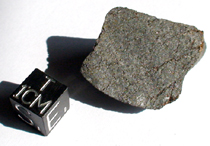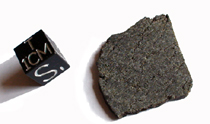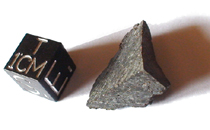Ureilites
The ureilites are named for Novo Urei, a rural village in the Mordova
Republic, Russia, where several meteorites fell in late 1886.
The ureilites are subdivided into two groups: the monomict main group
and the less common polymict group. Main group ureilites are composed
largely of coarse-grained olivine and minor pyroxene, mostly in the form
of calcium-poor pigeonite, set in a dark carbonaceous matrix of graphite
and diamond, nickel-iron metal, and troilite. Our recent find, El Gouanem,
Morocco, is a rather typical member of the main group. Polymict ureilites
consist of a mixture of different lithologies. Besides clasts from main
group ureilites, they contain magmatic inclusions, dark carbonaceous
clasts, chondritic fragments of different origins, and various other
inclusions. This suggests a surface or regolith origin for the polymict
ureilites, an assumption that is supported by the values for noble gases
that have been implanted into the regolith by the solar wind.
|
NWA
2236
Found
1999, South East Morocco
Achondrite
(Ureilite)
TKW : only 29.8 g
Shock stage S1, weathering grade W1.
Opx-Aug ureilite,
NWA 2236 with Mg-rich olivine
!!!
|
 
|
|
|
|
NWA 2236 -
00
Broken in several pieces, 13.80 gr
Endcut main mass covered of fresh fusion crust !
price
on request |
|
|
|
|
|
|
|
NWA 2236 - 01 2.98 gr
Very nice and thin
slice for this rare Ureilite
SOLD
|
|
|
|
  |
|
|
|
|
|
|
 
|
|
|
|
NWA 2236 - 02 2.58 gr
Nice triangular endcut with crust and two windows
!
SOLD
Price
on request
|
|
|
|
|
|
|
|